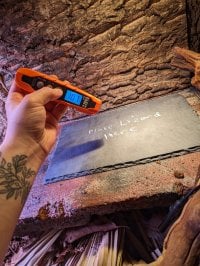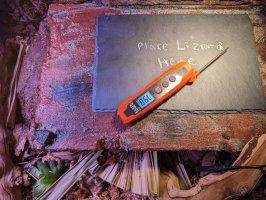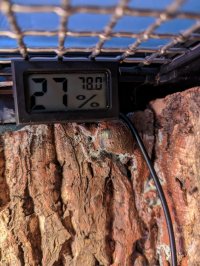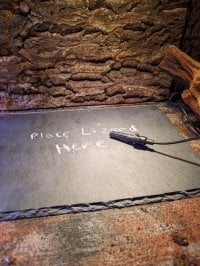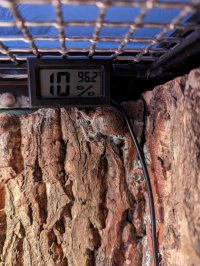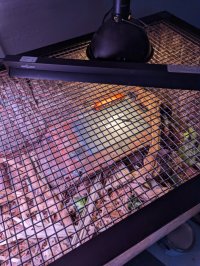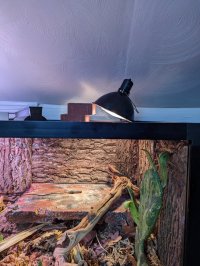Hi! I'm setting up an enclosure (don't have the lizard yet) but I'm having trouble getting the temperatures just right. This will be a long post but I want to include anything that may be applicable so please read carefully.
I have a slate basking platform that is 13" from the basking light. I am using a Klein dual-sensor infrared and probe thermometer. The IR sensor reads 107°F in the hottest spot, as pictured. But, if I lay the probe in the same spot and wait a few minutes for it to stop updating, it only reads about 80.
I have another digital probe which I've placed about 6" from the center of the basking spot (you can see it in the bottom of the picture where I'm using the probe end of the Klein gun) and it reads 78, seemingly confirming an air temperature of about 80° around the basking spot, which seems really cold given the surface temp.
If I place the digital probe right in the center of the basking spot, it gets to about 103° but only after being left for about an hour. The 96.8 reading pictured was after about 20-30 minutes of being sat there.
I am using a Philips 72W halogen flood light, but it's on a dimmer and turned down about halfway. If I turn it up closer to full power I can get the air temps to 90-95°, but then the IR thermometer reads 120-130° in the center of the basking spot! It's cooler (about 100-110°) as I move away from the very center, but the hottest spot is way hotter than the recommended temperatures. When I put the black digital probe right in the center of the beam with the light at higher power, it also gets up to about 120° after an hour or so.
There is an LED light on the other side of the enclosure for plants. The UVB tube is not turned on as I'm expecting it won't affect the heat much. The room is about 70°F right now. The top of the enclosure is a wide mesh (pictured) so I know a lot of heat is lost that way.
Why is my basking spot so much hotter than the air around it? Is it actually okay for it to be >120° in the hottest spot since it's just soaking up and holding this heat, and it's significantly cooler just a few inches away? Or, should I leave the bulb on the lower setting and cover parts of the mesh top to hold in more heat? Should I use an entirely different kind of bulb? Should I add a CHE and leave the bulb on its lower power?
Thanks so much for taking the time to read this, please let me know what you think!
I have a slate basking platform that is 13" from the basking light. I am using a Klein dual-sensor infrared and probe thermometer. The IR sensor reads 107°F in the hottest spot, as pictured. But, if I lay the probe in the same spot and wait a few minutes for it to stop updating, it only reads about 80.
I have another digital probe which I've placed about 6" from the center of the basking spot (you can see it in the bottom of the picture where I'm using the probe end of the Klein gun) and it reads 78, seemingly confirming an air temperature of about 80° around the basking spot, which seems really cold given the surface temp.
If I place the digital probe right in the center of the basking spot, it gets to about 103° but only after being left for about an hour. The 96.8 reading pictured was after about 20-30 minutes of being sat there.
I am using a Philips 72W halogen flood light, but it's on a dimmer and turned down about halfway. If I turn it up closer to full power I can get the air temps to 90-95°, but then the IR thermometer reads 120-130° in the center of the basking spot! It's cooler (about 100-110°) as I move away from the very center, but the hottest spot is way hotter than the recommended temperatures. When I put the black digital probe right in the center of the beam with the light at higher power, it also gets up to about 120° after an hour or so.
There is an LED light on the other side of the enclosure for plants. The UVB tube is not turned on as I'm expecting it won't affect the heat much. The room is about 70°F right now. The top of the enclosure is a wide mesh (pictured) so I know a lot of heat is lost that way.
Why is my basking spot so much hotter than the air around it? Is it actually okay for it to be >120° in the hottest spot since it's just soaking up and holding this heat, and it's significantly cooler just a few inches away? Or, should I leave the bulb on the lower setting and cover parts of the mesh top to hold in more heat? Should I use an entirely different kind of bulb? Should I add a CHE and leave the bulb on its lower power?
Thanks so much for taking the time to read this, please let me know what you think!

